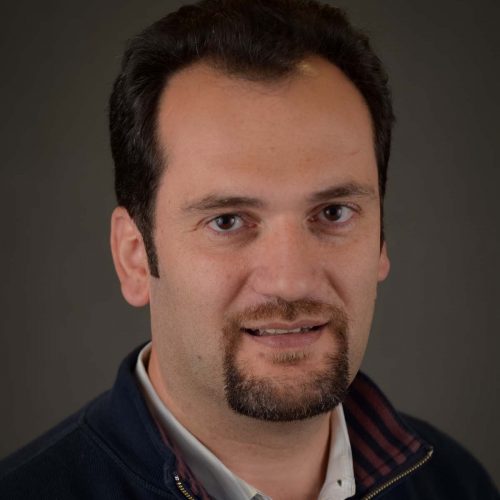Chadi Sayde
Assistant Professor

- 919-515-6702
- csayde@ncsu.edu
- D S Weaver Labs 184
- View CV
Dr. Sayde grew up in a multi-generational farming family. From an early age, he was exposed daily to the practical challenges of agricultural production under the rapidly increasing impacts of climate change on available water resources. This was the main motivation for him to seek a B.S. degree in agricultural engineering from the University of Holy Spirit, Lebanon, then a M.S. degree in Land and Water Resources Management from the Mediterranean Agricultural Institute of Bari, Italy. Finally, he received his Ph.D. in Water Resources Engineering from Oregon State University (OSU). He was advised by one of the pioneers in optimum irrigation management, Dr. Marshall English, as well as one of the world leaders in vadose zone hydrology and environmental monitoring, Dr. John Selker. In his PhD and post-doctoral work at OSU he focused on developing cutting edge tools that allow the interrogation of our environment at a range of temporal and spatial scales never attempted before. For instance, he demonstrated the feasibility of using actively heated fiber optics (soil-AHFO) method in conjunction with Distributed Temperature Sensing (DTS) to quantify soil water content and fluxes at spatial scales spanning over 4 orders of magnitude (0.1 m to 1,000 m) and temporal scale well below 1 h. He also developed a novel approach to continuously measure wind speed simultaneously at thousands of points using actively heated fiber optics (air-AHFO). Dr. Sayde joined the Department of Biological and Agricultural Engineering in January of 2017 as an assistant professor.
Education
Water Resources Engineering
Oregon State University
Land and Water Resources Management
Istituto Agronomico Mediterraneo di Bari, Italy
Agricultural Engineering
University of Holy Spirit, Kaslik, Lebanon
Research Description
Dr. Sayde believes that sustainable management of our agricultural and natural systems requires a paradigm shift in the way we manage our water. This paradigm shift will be largely driven by a new generation of physically based models and tools that enable continuous monitoring of our environment over wide range of temporal and spatial scales. Dr. Sayde research is focused on developing and employing advanced models and sensing systems to quantify water and energy movement across the soil-plant-atmosphere continuum from individual plants, to field and watershed scales. His objectives are to employ the ultra-high density of initial and boundary conditions measurements across the landscape to i) understand the underlying physical processes and the interaction between water, atmosphere, soil, topography, and vegetation, and ii) formulate engineered solutions to agricultural water management challenges that optimize economical return of water and minimize its adverse environmental impacts. Areas of interests include: - quantifying and understanding physical processes that control energy and water movement through the soil-plant-atmosphere continuum at 0.25-10,000 m scales -development of distributed environmental sensing systems -design and management optimization of irrigation systems -development of physically based agricultural water management models
Publications
- High-Resolution Monitoring of Scour Using a Novel Fiber-Optic Distributed Temperature Sensing Device: A Proof-of-Concept Laboratory Study
- Hatley, R., Shehata, M., Sayde, C., & Castro-Bolinaga, C. (2023), SENSORS, 23(7), 3758. https://doi.org/10.3390/s23073758
- Optimization of the number and locations of the calibration stations needed to monitor soil moisture using distributed temperature sensing systems: A proof-of-concept study
- Shehata, M., Gentine, P., Nelson, N., & Sayde, C. (2023), JOURNAL OF HYDROLOGY, 620. https://doi.org/10.1016/j.jhydrol.2023.129449
- Characterizing soil water content variability across spatial scales from optimized high-resolution distributed temperature sensing technique
- Shehata, M., Gentine, P., Nelson, N., & Sayde, C. (2022), JOURNAL OF HYDROLOGY, 612. https://doi.org/10.1016/j.jhydrol.2022.128195
- High-Resolution Field Measurement of Soil Heat Capacity and Changes in Soil Moisture Using a Dual-Probe Heat-Pulse Distributed Temperature Sensing Approach
- Shehata, M., Heitman, J., & Sayde, C. (2022), WATER RESOURCES RESEARCH, 58(6). https://doi.org/10.1029/2021WR031680
- A Model for Turbulence Spectra in the Equilibrium Range of the Stable Atmospheric Boundary Layer
- Cheng, Y., Li, Q., Argentini, S., Sayde, C., & Gentine, P. (2020), JOURNAL OF GEOPHYSICAL RESEARCH-ATMOSPHERES, 125(5). https://doi.org/10.1029/2019JD032191
- High-Resolution Measurement of Soil Thermal Properties and Moisture Content Using a Novel Heated Fiber Optics Approach
- Shehata, M., Heitman, J., Ishak, J., & Sayde, C. (2020), WATER RESOURCES RESEARCH, 56(7). https://doi.org/10.1029/2019WR025204
- Classifying the nocturnal atmospheric boundary layer into temperature and flow regimes
- Pfister, L., Lapo, K., Sayde, C., Selker, J., Mahrt, L., & Thomas, C. K. (2019), QUARTERLY JOURNAL OF THE ROYAL METEOROLOGICAL SOCIETY, 145(721), 1515–1534. https://doi.org/10.1002/qj.3508
- A high resolution measurement of the morning ABL transition using distributed temperature sensing and an unmanned aircraft system
- , (2018). Environmental Fluid Mechanics. https://doi.org/10.1007/s10652-017-9569-1
- Failure of Taylor's hypothesis in the atmospheric surface layer and its correction for eddy-covariance measurements
- Cheng, Y., Sayde, C., Li, Q., Basara, J., Selker, J., Tanner, E., & Gentine, P. (2017), Geophysical Research Letters, 44(9), 4287–4295. https://doi.org/10.1002/2017gl073499
- Quantitative analysis of the radiation error for aerial coiled-fiber-optic distributed temperature sensing deployments using reinforcing fabric as support structure
- Sigmund, A., Pfister, L., Sayde, C., & Thomas, C. K. (2017), Atmospheric Measurement Techniques, 10(6), 2149–2162. https://doi.org/10.5194/amt-10-2149-2017
